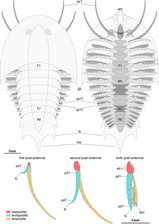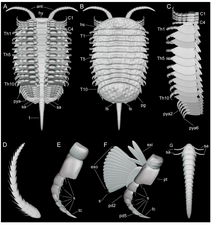三葉形類
| 三葉形類 | ||||||||||||
|---|---|---|---|---|---|---|---|---|---|---|---|---|

| ||||||||||||
| 分類 | ||||||||||||
| ||||||||||||
| 学名 | ||||||||||||
| Trilobitomorpha Størmer, 1944[2][3] | ||||||||||||
| 下位分類群[5] | ||||||||||||
三葉形類(さんようけいるい、Trilobitomorpha)は、古生代の三葉虫類・ナラオイア・ヘルメティア・シャンダレラなどを含む化石節足動物の分類群[6][1]。別名三葉虫様類[7]。
古典的には独自の亜門(三葉形亜門)とされていた[4]が、21世紀以降では光楯類などと共にArtiopoda[8]亜門[1]に分類されるようになった[6][1]。
形態
[編集]背面構造
[編集]体の背面は横に出張った幅広い外骨格(背板 tergite)に覆われている。三葉虫の場合は硬く生物鉱化し(炭酸カルシウム質)、中央の軸部 (axial region) と左右の肋部 (pleural region) は明瞭な溝 (axial furrow) に分かれるが、他の種類は比較的柔らかく、軸部と肋部の境目は不明瞭である。十数節以上の体節は前後で頭部 (cephalon) と胴部 (trunk) に、胴部は更に胸部 (thorax) と尾部 (pygidium) という計3つの合体節にまとめられる。通常、頭部と尾部の背板はそれぞれ一枚板状に癒合し、胸部の背板は体節ごとに分節するが、独立した胸節をもたない種類(ナラオイアなど)や全ての背板が一体化した種類(サペリオンなど)もいる[8]。Conciliterga類の場合、頭部の先端には小さな甲皮 (anterior sclerite) がある[8][6][9]。1対の側眼(複眼)は種類により頭部の両縁(シャンダレラなど)、腹面(Conciliterga類など)、もしくは背面(三葉虫など)に配置され、退化消失した例もいる(Nektaspida類など)[10]。
腹面構造
[編集]各体節由来の付属肢(関節肢)は全てが体の腹面に覆われ、先頭には1対の触角、それ以降には数多くの脚が並んでいる。脚は頭部に少なくとも3対、胸部に原則として背板1枚につき1対(Xandarellida類の場合、対の数が背板数より多い)、尾部に複数対をもつ[8][6]。触角と第1脚の間には1枚のハイポストーマ (hypostome) があり、後ろに向けて開いた口を覆いかぶさる[8][6]。脚は原節 (basipod) から枝分かれた内肢 (endopod) と外肢 (exopod) でできた二叉型付属肢であり、内肢は原則として7節に分かれた歩脚型、外肢は原則として長い葉状の構造体 (lamellae) が縁に沿って数多く並んでいる[6]。通常、触角は細長い糸状、脚は前後を通じてほぼ同じ構造の繰り返しであり[8]、著しい特化はごく一部の種類のみに見られる(シノブリウスの短縮した触角と触角状の第1-2外肢[10]・オレノイデスの尾毛と途中2対のクラスパー状の脚[11]など)。
生態
[編集]多くのArtiopoda類と似て、三葉形類は原則として海底を這い回る底生生物で、食性は多くが堆積物食性・腐肉食性・捕食性のいずれかに該当するとされ[8][12][13][14]、ごく一部のみ外洋性(浮遊性/遊泳性)・濾過摂食性とされる[15]。採餌の際、腹側の付属肢を用いて後方から前方に向かって食物を運動させて摂食するとされる[4]。
生息時代
[編集]三葉形類の化石は古生代の地質時代の堆積層のみから知られている。カンブリア紀前期で多様化しており[1]、中でも三葉虫はペルム紀後期まで生き延びていたが、それ以外はほとんどがカンブリア紀に限定され、Nektaspida類のみ直後のオルドビス紀とシルル紀にも生息した[16]。
分類
[編集]
| ||||||||||||||||||||||||||||||||||||||||||
| 三葉形類の系統関係 |
三葉形類 Trilobitomorpha は Leif Størmer によって1944年に節足動物の1亜門として提唱され、鋏角類(と当時に原始的な鋏角類と誤解釈された光楯類 Aglaspidida)はそこから触角が退化して前脚が鋏角に変化するように起源すると考えられた[2]。1959年、三葉形類の内部系統は三葉虫綱 Trilobita と三葉甲綱[4] Trilobitoidea の2綱からなる分類群として定義された[17]。エメラルデラ類 Emeraldellida(エメラルデラなど)・マルレロモルフ類 Marrellomorpha(マーレラなど)・レティファシス類 Retifaciida(レティファシスなど)がその外群に位置するとも考えられた[7]。
しかし21世紀以降の見解は前述した分類体系を支持しなかった。鋏角類の鋏角は遺伝子発現などにより触角に相同であると判明したことで、前述の鋏角類との類縁関係の基準が否定的となり、それ以降の三葉形類(およびそれを内包するArtiopoda類全般)と現生節足動物の類縁関係も諸説に分かれて不確実である(鋏角類と大顎類のいずれかに近縁、もしくはそれらより基盤的な真節足動物)[18]。系統解析結果では、エメラルデラ類は三葉形類の代わりに光楯類やケロニエロン類 Cheloniellida(ケロニエロンなど)と単系統群 (Vicissicaudata) を成し、マルレロモルフ類はかけ離れた別系統(大顎類に近縁[6][1][19][10]、もしくは基盤的な真節足動物[20])とされる。Hou & Bergström 1997[8] 以降の分類体系では、三葉形類とVicissicaudata類の構成種は一般にArtiopoda類としてまとめられ、これは Lerosey-Aubril et al. 2017 により亜門として定義される[1]。
下位分類
[編集]三葉形類は主に三葉虫類・Conciliterga類(ヘルメティアなど)・Nektaspida類(ナラオイアなど)・Xandarellida類(シャンダレラなど)の4群からなり、他にもレティファシスなど孤立した属がいくつか含まれる。三葉形類自体、および前述の4群のそれぞれの単系統性は複数の系統解析に支持される[21][22][6][19][10][23][5]。多くの場合、三葉形類はVicissicaudata類の姉妹群、レティファシスなどは基盤的な三葉形類、Nektaspida類はXandarellida類に、Conciliterga類は三葉虫類に近縁とされる[6][19][10][23]。
- Trilobitomorpha 三葉形類
- Kwanyinaspis(三葉形類から除外される場合がある[6])
- Pygmaclypeatus
- Retifacies レティファシス
- Conciliterga (=Helmetiida)
- Nektaspida (=Naraoiida/Nektaspia/Nectaspida)
- Buenaspis(Nektaspida類から除外される場合がある[24])
- Emucarididae 科
- Liwiidae 科
- Naraoiidae ナラオイア科
- Naraoia ナラオイア
- Misszhouia ミスゾウイア
- 三葉虫綱 Trilobita
- (該当項目を参照)
- Xandarellida (=Petalopleura)
- Cindarella シンダレラ
- Luohuilinella
- Phytophilaspis フィトフィラスピス(Xandarellida類から除外される場合がある[1])
- Sinoburius シノブリウス
- Xandarella シャンダレラ
脚注
[編集]- ^ a b c d e f g h Lerosey-Aubril, Rudy; Zhu, Xuejian; Ortega-Hernández, Javier (2017-12). “The Vicissicaudata revisited – insights from a new aglaspidid arthropod with caudal appendages from the Furongian of China” (英語). Scientific Reports 7 (1): 11117. doi:10.1038/s41598-017-11610-5. ISSN 2045-2322. PMC 5593897. PMID 28894246.
- ^ a b Størmer, L. (1944). “On the relationships and phylogeny of fossils and recent Arachnomorpha. A comparative study of Arachnida, Xiphosura, Eurypterida, Trilobita and other fossil Arthropoda”. Skrifter utgitt av Det Norske Videnskaps-Akademi i Oslo. I. Matematisk-Naturvidenskapelig Klasse 5:: 1–158.
- ^ Zhi-Qiang Zhang (2011), “Phylum Arthropoda von Siebold, 1848”. In: Zhang, Z.-Q. (Ed.) Animal biodiversity: An outline of higher-level classification and survey of taxonomic richness. Zootaxa, Volume 4138, Magnolia Press, Pages 99-103.
- ^ a b c d 浜田隆士「三葉虫類等に関する国際学術集会 (1973年, オスロー)」『地学雑誌』第83巻第4号、1974年、257-269頁、doi:10.5026/jgeography.83.4_257。

- ^ a b Zhang, Maoyin; Liu, Yu; Hou, Xianguang; Ortega-Hernández, Javier; Mai, Huijuan; Schmidt, Michel; Melzer, Roland R.; Guo, Jin (2022-08). “Ventral Morphology of the Non-Trilobite Artiopod Retifacies abnormalis Hou, Chen & Lu, 1989, from the Early Cambrian Chengjiang Biota, China” (英語). Biology 11 (8): 1235. doi:10.3390/biology11081235. ISSN 2079-7737.
- ^ a b c d e f g h i j Ortega-Hernández, Javier; Legg, David A.; Braddy, Simon J. (2013). “The phylogeny of aglaspidid arthropods and the internal relationships within Artiopoda” (英語). Cladistics 29 (1): 15–45. doi:10.1111/j.1096-0031.2012.00413.x. ISSN 1096-0031.
- ^ a b 鈴木雄太郎「三葉虫綱」石川良輔編『節足動物の多様性と系統』〈バイオディバーシティ・シリーズ〉第6巻、岩槻邦男・馬渡峻輔監修、裳華房、2008年、114-121頁。
- ^ a b c d e f g h Hou, Xianguang; Bergström, Jan (1997) (English). Arthropods of the Lower Cambrian Chengjiang fauna, southwest China. Oslo; Boston: Scandinavian University Press. ISBN 978-82-00-37693-4. OCLC 38305908
- ^ Ortega-Hernández, Javier (2015-06-15). “Homology of Head Sclerites in Burgess Shale Euarthropods” (English). Current Biology 25 (12): 1625–1631. doi:10.1016/j.cub.2015.04.034. ISSN 0960-9822.
- ^ a b c d e Chen, Xiaohan; Ortega-Hernández, Javier; Wolfe, Joanna M.; Zhai, Dayou; Hou, Xianguang; Chen, Ailin; Mai, Huijuan; Liu, Yu (2019-08-06). “The appendicular morphology of Sinoburius lunaris and the evolution of the artiopodan clade Xandarellida (Euarthropoda, early Cambrian) from South China”. BMC Evolutionary Biology 19 (1): 165. doi:10.1186/s12862-019-1491-3. ISSN 1471-2148. PMC 6685191. PMID 31387545.
- ^ Losso, Sarah R.; Ortega-Hernández, Javier (2022-08-01). “Claspers in the mid-Cambrian Olenoides serratus indicate horseshoe crab–like mating in trilobites” (英語). Geology 50 (8): 897–901. doi:10.1130/G49872.1. ISSN 0091-7613.
- ^ Zhai, Dayou; Edgecombe, Gregory D.; Bond, Andrew D.; Mai, Huijuan; Hou, Xianguang; Liu, Yu (2019-12-04). “Fine-scale appendage structure of the Cambrian trilobitomorph Naraoia spinosa and its ontogenetic and ecological implications” (英語). Proceedings of the Royal Society B: Biological Sciences 286 (1916): 20192371. doi:10.1098/rspb.2019.2371. ISSN 0962-8452. PMC PMC6939273. PMID 31795867.
- ^ Holmes, James D.; Paterson, John R.; García-Bellido, Diego C. (2020-02-16). “The trilobite Redlichia from the lower Cambrian Emu Bay Shale Konservat-Lagerstätte of South Australia: systematics, ontogeny and soft-part anatomy” (英語). Journal of Systematic Palaeontology 18 (4): 295–334. doi:10.1080/14772019.2019.1605411. ISSN 1477-2019.
- ^ Bicknell, Russell D. C.; Holmes, James D.; Edgecombe, Gregory D.; Losso, Sarah R.; Ortega-Hernández, Javier; Wroe, Stephen; Paterson, John R. (2021-01-27). “Biomechanical analyses of Cambrian euarthropod limbs reveal their effectiveness in mastication and durophagy” (英語). Proceedings of the Royal Society B: Biological Sciences 288 (1943): 20202075. doi:10.1098/rspb.2020.2075. ISSN 0962-8452. PMC PMC7893260. PMID 33499790.
- ^ McCormick, Tim; Fortey, Richard A. (1998-04). “Independent testing of a paleobiological hypothesis: the optical design of two Ordovician pelagic trilobites reveals their relative paleobathymetry” (英語). Paleobiology 24 (2): 235–253. doi:10.1666/0094-8373(1998)024[0235:ITOAPH]2.3.CO;2. ISSN 0094-8373.
- ^ Caron, Jean-Bernard; Rudkin, David M.; Milliken, Stuart (2004-11). “A new Late Silurian (Pridolian) naraoiid (Euarthropoda: Nektaspida) from the Bertie Formation of southern Ontario, Canada—delayed fallout from the Cambrian explosion” (英語). Journal of Paleontology 78 (6): 1138–1145. doi:10.1666/0022-3360(2004)078<1138:ANLSPN>2.0.CO;2. ISSN 0022-3360.
- ^ 小林貞一「三葉虫綱の自然分類について」『地質学雑誌』第66巻第779号、日本地質学会、1960年、538-546頁。
- ^ Giribet, Gonzalo; Edgecombe, Gregory D. (2019-06). “The Phylogeny and Evolutionary History of Arthropods”. Current Biology 29 (12): R592–R602. doi:10.1016/j.cub.2019.04.057. ISSN 0960-9822.
- ^ a b c Du, Kun‐sheng; Ortega‐Hernández, Javier; Yang, Jie; Zhang, Xi‐guang (2019-06). “A soft‐bodied euarthropod from the early Cambrian Xiaoshiba Lagerstätte of China supports a new clade of basal artiopodans with dorsal ecdysial sutures” (英語). Cladistics 35 (3): 269–281. doi:10.1111/cla.12344. ISSN 0748-3007.
- ^ Aria, Cédric; Caron, Jean-Bernard (2017-05). “Burgess Shale fossils illustrate the origin of the mandibulate body plan” (英語). Nature 545 (7652): 89–92. doi:10.1038/nature22080. ISSN 1476-4687.
- ^ Edgecombe, G.D., Ramsköld, L., 1999. Relationships of Cambrian Arachnata and the systematic position of Trilobita. J. Paleontol. 73, 263–287.
- ^ Cotton, T.J., Braddy, S.J., 2004. The phylogeny of arachnomorph arthropods and the origin of Chelicerata. Trans. R. Soc. Edinburgh: Earth Sci. 94 (for 2003), 169–193.
- ^ a b Jiao, De-Guang; Du, Kun-Sheng; Zhang, Xi-Guang; Yang, Jie; Eggink, Daniel (2022-05). “A new small soft-bodied non-trilobite artiopod from the Cambrian Stage 4 Guanshan Biota” (英語). Geological Magazine 159 (5): 730–734. doi:10.1017/S0016756821001254. ISSN 0016-7568.
- ^ Paterson, John R.; Edgecombe, Gregory D.; GarcíA‐Bellido, Diego C.; Jago, James B.; Gehling, James G. (2010-03). “Nektaspid arthropods from the Lower Cambrian Emu Bay Shale Lagerstätte, South Australia, with a reassessment of lamellipedian relationships” (英語). Palaeontology 53 (2): 377–402. doi:10.1111/j.1475-4983.2010.00932.x. ISSN 0031-0239.
Text is available under the CC BY-SA 4.0 license; additional terms may apply.
Images, videos and audio are available under their respective licenses.




